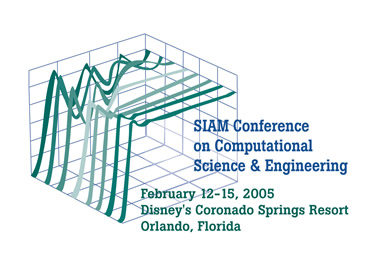
Sponsored by SIAM Activity Group on Computational Science and Engineering (SIAG CSE)
 SIAM/ACM Prize in Computational Science and Engineering
SIAM/ACM Prize in Computational Science and Engineering
About the Conference
If applying for a VISA, please remember to allow ample time for the application process. See “Conference Information” for a link to the National Academies who can provide further information.
Themes
- Advanced Discretization Methods
- Computational Biology and Bioinformatics
- Computational Chemistry and Chemical Engineering
- Computational Earth and Atmospheric Sciences
- Computational Electromagnetics
- Computational Fluid Dynamics
- Computational Medicine and Bioengineering
- Computational Physics and Astrophysics
- Computational Solid Mechanics and Materials
- CS&E Education
- Datamining and Stream Mining
- Discrete and Combinatorial Algorithms for CS&E
- Inverse Problems
- Meshing and Adaptivity
- Multiscale and Multiphysics Problems
- Numerical Algorithms for CS&E
- Optimal Design, Optimal Control, and Inverse Problems
- Parallel and Distributed Computing
- Problem-Solving Environments
- Semiconductor Device Simulation
- Software and Middleware Systems
- Uncertainty Estimation and Sensitivity Analysis and Software Validation and Verification
- Visualization, Computer Graphics, and Human-Computer Interaction
Description
Computational Science and Engineering (CS&E) is now widely accepted, along with theory and experiment, as a crucial third mode of scientific investigation and engineering design. Aerospace, automotive, biological, chemical, semiconductor, and other industrial sectors now rely on simulation for technical decision support. For federal agencies also, CS&E has become an essential support for decisions on resources, transportation, and defense. Finally, in many new areas such as medicine, the life sciences, management and marketing (e.g. data- and stream mining), and finance techniques and algorithms from CS&E are of growing importance.
CS&E is by nature interdisciplinary. It grows out of physical applications and it depends on computer architecture, but at its heart are powerful algorithms. Much of CS&E has involved analysis, but the future surely includes optimization and design, especially in the presence of uncertainty. Another mathematical frontier is the assimilation of very large data sets through such techniques as adaptive multiresolution, automated feature search, and low-dimensional parameterization.
SIAM is conducting this conference on CS&E to draw attention to the tremendous range of major computational efforts on large problems in science and engineering, to promote the interdisciplinary culture required to meet these large-scale challenges, and to encourage the training of the next generation of computational scientists.
Funding Agency
SIAM and the conference organizing committee wish to extend their thanks and appreciation to the National Science Foundation for its support of this conference.
Organizing Committee
Co-Chairs:
Lori Freitag Diachin, Lawrence Livermore National Laboratory
Eric de Sturler, University of Illinois, Urbana-Champaign
John Shadid, Sandia National Laboratories
Timothy Barth, NASA Ames Research Center
Iain Duff, Rutherford Appleton Laboratory, United Kingdom and CERFACS, France
Omar Ghattas, Carnegie Mellon University
James Glimm, State University of New York, Stony Brook
Robert J. Harrison, Oak Ridge National Laboratory
Thomas Hughes, University of Texas, Austin
Steve Jardin, Princeton University
Kirk Jordan, IBM Life Sciences Solutions
Laxmikant
Kale, University of Illinois, Urbana-Champaign
Tamara G. Kolda, Sandia National Laboratories
Jill Mesirov, The Eli and Edythe L. Broad Institute, MIT and Harvard University
Anthony Mezzacappa, Oak Ridge National Laboratory
Sadasivan Shankar, Intel Corporation
Anne Trefethen, Engineering and Physical Sciences Research Council, United Kingdom
Mary Wheeler, University of Texas, Austin